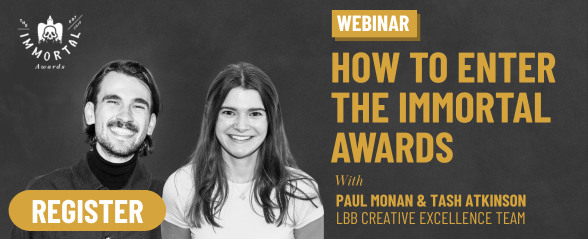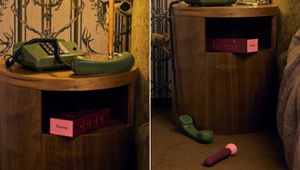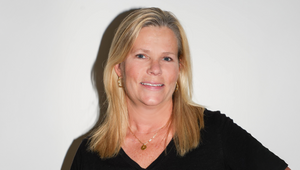
How Creativity Solves Problems: Reflections on my DMA Awards Jury Experience

Journalists don’t often get asked to judge on marketing industry award shows. But I’m grateful that last week I was able to return for my third year as part of the jury for the DMA Awards. While we argue as an editorial team over the quality of creative work pretty much every day at LBB Towers, doing it with a group of people who’ve worked on campaigns directly is its own kind of joy. Because, although I love our daily discussions of what to prioritise for the LBB newsletter or Work of the Week, being in a room full of practitioners from different specialisms brings a quality of debate I don’t get elsewhere.
As Little Black Book was the category sponsor, I’d been invited to judge in the Creative Solution category, defined by the UK data and marketing trade body that runs the awards as the “category for creative thinking in solving a particular marketing challenge for either B2B or B2C work[…] displaying creative innovation that delivers action-orientated communications or experiences.”
The category judges spanned more professional backgrounds than you might expect, which meant we were coming at the entries from an impressive range of perspectives. There were creative directors (for the ‘creative’ part), strategists (helpful for the ‘solution’ part), marketers, media planning and data experts. I brought a broader base of insights, developed over 11 years evaluating creative campaigns to decide what’s worthy of exploring in the trade press, even though I’ve never actually worked behind a marketing campaign.
Keeping the goal of the day in focus was Sue Daun, executive creative director for brand consultancy Interbrand – someone who’s seen and done her fair share of creative problem-solving for clients.
Sue guided us through the description of the category as defined by the DMA to help get us in the mindset to assess the work.
Each entry should show:
- A strong idea that shows creative originality as well as appropriateness for the brand
- An outline of the strategy and target audience
- Results to reassure the judges that the work was effective
The morning was quiet – a chance for us all to privately weigh up the entries on tablets that had been provided, reading the details about each campaign. After feedback that the quality of case study videos can often mislead juries, it was interesting to note that the only video we were able to watch in the morning was part of the campaign itself – swish production budgets applied to swaying jurors carried less weight this year. And we all had to focus, reading carefully through how each campaign identified a client problem and used creativity to solve it.
Every juror had the entries listed in a different order, which helped us to form our own opinions. If someone across the table was groaning at something they didn’t approve of, it was impossible for me to guess which entry they were weighing up.
After a quiet morning of weighing up and rating the entries on our tablets, we had lunch to refresh our evaluative faculties and then cracked on with our discussion of the work that we’d put through to our longlist – about half of the entries we’d sifted through in the morning.
This is when we got to watch the case studies for the entries that had them. And some of them highlighted things that we hadn’t fully appreciated reading the written entries.
The discussion from there was civilised and surprisingly conflict free. Sue would suggest a campaign to discuss and ask if one of us had a particularly strong view to express on it. From there, the discussion progressed organically. People didn’t need to be prompted to debate the important topics, but when someone had been quieter, Sue encouraged them to share a view. It was smooth and free-flowing.
As is so often the case in creative awards judging, the numbers used to prop up the entries were something we subject to serious scepticism. Does this metric really demonstrate that the creative solution solved the problem that the client had? Often we found it difficult to understand why. Thankfully our scores for the results were only weighted at 20% of the overall points. 60% was on the creative itself, which was a reminder to put that first as we decided what was worth awarding.
There were a few debates which went a long way towards how we ended up choosing our shortlist and winners. One was the importance of identifying the problem that the campaign was solving. Sometimes this was a business problem that the brand genuinely needed to address. We found that more compelling than when the problem felt like it didn’t go as deep – that the client just wanted to do some marketing.
Another debate was around whether we were impressed by the creative solution – i.e. the way that a creative idea responded to a client’s specific challenges – or just by the creative execution – a beautifully made piece of storytelling, crafted by the most skilful talent the industry has to offer.
As a jury, we collectively loved some of the ideas that we decided to mark down. We just didn’t think they were impressive enough when we looked at them through the ‘Creative Solution’ lens. Some deserved awards in different categories, we agreed, but we couldn’t see a clear line from a client’s business problem to the solution the creativity delivered.
When it comes to work with a strong social or environmental purpose at its heart alongside more prosaic commercial goals, we discussed the importance of weighing up which problem the creativity is trying to solve and how effective it is at doing both. It takes a clever idea to drive brand, performance and broader goals for people and planet simultaneously.
There was heated disagreement over some pieces of work which really highlighted how a room with so many differing perspectives ensures every entry is fairly evaluated. I changed my mind on a few pieces having heard strong arguments that won me over.
By the end of the day, we’d built a shortlist we were confident demonstrated creative solutions in a way that should inspire our industry to do better work. Two in particular were pioneering solutions, we felt.
Here are the five campaigns we put through:
Agency: BBH and Essence Mediacom
Client: Tesco Mobile
Agency: Ogilvy UK
Client: Dove
Agency: RAPP
Client: Ann Summers
Agency: RAPP
Client: London Youth
Agency: The Croc
Client: ABAX
Part of my job as deputy editor and EMEA editor at LBB is deciding what creative problem-solving is most worthy of celebrating and shining a spotlight on. But it does hit different when I get to do that with a new group of expert practitioners, rather than the editorial team that I know and love. It felt worthwhile and I made some new industry friends along the way.
I look forward to finding out what work won at the DMA Awards Night 2023 on Tuesday, December 5th.
Thanks to the DMA for including me in this process.















